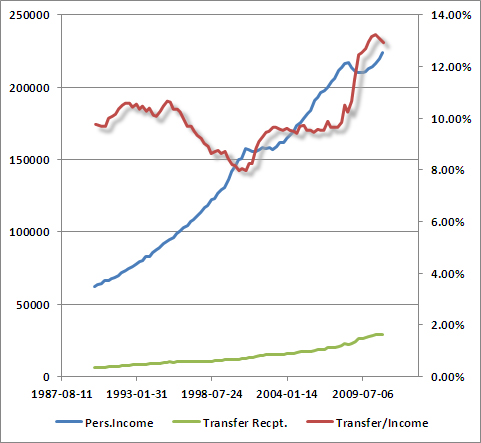Posts Tagged Entitlements
Defensive Gymnastics
Posted by Joshua Sharf in 2012 Presidential Race, PPC on January 17th, 2012
Last night, Rick Santorum and Newt Gingrich went head-to-head on the long-term solvency of Social Security. Gingrich proposed – again – individual accounts, modeled after the highly successful Chilean “Little Passbook” system. (From Gingrich’s remarks, the system’s architect, Jose Pinera, was slated to give a presentation on the subject later, but you can see him speak here.) Santorum pointed out the plan’s Achilles’ Heel, the cost of covering defined benefits to current and soon-to-be recipients during the transition.
Instead, Santorum, and then Romney, proposed more tweaks to the system, of the kind that have gotten us into this mess in the first place. Santorum’s solution, raising the retirement age a couple of years, isn’t going to solve a mismatch caused by declining birth rates and decades-longer life spans. Romney’s seemed unaware of the existence of 401(k) accounts and IRAs.
To erstwhile Romney supporter Jennifer Rubin, however, not only is Santorum’s limited vision correct, it’s an excuse to boost the un-nominatable Santorum at the expense of Gingrich, who poses a real national threat to her candidate:
…we have a huge, nagging debt right now and he’s going to make it worse with his plan. And while Santorum was certainly right on substance, Gingrich’s glibness may have successfully concealed how really silly is his policy proposal.
In short, aside from the political hurdles (George Bush died on his sword over individual accounts) Gingrich’s Social Security plan is, as Santorum claimed, irresponsible.
Individual accounts funded by individual contributions – defined contribution accounts – are the right answer, and the longer we wait, the greater the cost, the greater the burden on the country’s finances. But to Rubin, the right answer, easier to implement today than tomorrow, is “irresponsible,” while ineffective tweaks and redundant savings plans are “right on substance.”
And this is only a taste of the defensive gymnastics, the excuses for timidity, the defenses of unnecessary compromise (and yes, folks, there is such a thing as necessary compromise) that a Romney presidency will likely bring.
No wonder those promises of “electability” are beginning to seem a little suspect.
A Transfer on the Road to Serfdom
Posted by Joshua Sharf in Business, Economics, PPC on August 3rd, 2011
As an emblem of what Walter Russell Mead calls, “the Blue Social Model,” there’s almost no place Bluer than New York. So it seems fitting to pay homage to the home of the modern patronage state in a post devoted to transfer payments.
We all know that transfer payments – Welfare, Social Security, Medicare, Medicaid, Unemployment Benefits – have been growing at an unsustainable pace, and are the source of our long-term structural problems. We’re also aware that once a program acquires a sufficient constituency, it’s almost impossible to reduce, let alone do away with. Thus the concern when the top few percent of earners pay 40% of all income tax, and when half the country pays no income tax at all.
This dramatic Calculated Risk post about recession measures has gotten a number of people’s attention, but what struck me was the qualifier on the Personal Income chart: less transfer receipts. Transfer receipts don’t count towards GDP, with good reason, but they certainly subtract from the country’s capital available for investment or spending. They’re also the key, most public, most obvious way of obtaining a constituency for higher taxes and continued spending. We’re now reaching the point where almost $1 out of every $5 of personal income comes from transfer payments (the scale on the left is in $ billions):

You can see the large boost given as Medicare and Medicaid took hold in the late 60s and early half of the 70s. Through the 80s and 90s, the numbers continued to slope upwards, but a robust economy kept them largely between 12% and 14%, or between 1/7 and 1/8 of personal income. Then, with the financial crisis and the preceding recession, they went through the roof. For the first time, a boost in transfer payments was also accompanied by a year-over-year drop in aggregate personal income. It’s that spending percentage that Obama and the Democrats want to lock in as the floor for the economy.
Colorado has it a little better, or maybe is just lagging behind the rest of the country (the scale on the left is in $ millions) :

In the 90s, as Colorado recovered from the commodities bust and attractive tech talent from around the country, the percentage of income derived from transfer payments fell just barely above 8%. The recession of the early ’00s hit, and the slower growth of that decade, while real, was only enough to just balance the increase in transfers. Some of this was a result of Colorado’s generosity to its own citizens, as the legislature loosened rules for Medicaid. The state, of course, followed the rest of the country in a near-vertical climb in ’09.
The number is starting to decline gently as unemployment benefits run out, and incomes begin to slowly recover.
The chart, although the time scale is different from the one for the country as a whole, points out the main lesson of all this: growth is the only way out of this problem. It can’t be healthy for $13 of every $100 of personal income to come from an unearned government check. It’s even worse for the country as a whole. And the deepening dependency of more and more people is only going to make the political will necessary to break this cycle harder to find.



